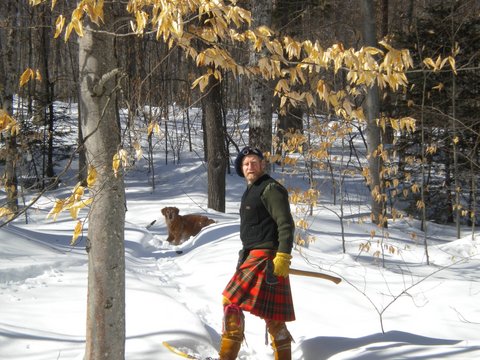Last month (November 2021) the Hunter’s full moon rose so large and orange in the east that my wife and I had no choice but to simply sit down on the porch and watch in awe. It was one of those wonderful moments that make one feel very small and insignificant in the grand sweep of life. As the cold crept in and the hard frost set up, my mind wandered to our Highland ancestors and, as is increasingly the case as I get on in years, I mused on the number of similar moments my forebears shared in Scotland watching the same moon hundreds and even thousands of years ago. It was a powerful connection.
Connections are important. They serve to anchor us in the past and help us better comprehend the future. More and more our modern society is understanding the importance of language and oral traditions and their critical role in unlocking the traditions of culture and heritage. Take away native spoken or written language and you take away the culture. For these reasons, all over the world there has been a renaissance of classes and teaching aids to help orphaned cultures repatriate their unique contributions.
We here in Canada are in the early stages of trying to redefine the role and relationship between peoples indigenous to what is now Canada and the immigrants who landed here to establish new lives in the “new” world. Our Scottish ancestors arrived as early fur traders, hardworking farmers and industrialists and played a significant role in this story.
Today there is controversy surrounding this chapter in our history. As we work to sort this out and acknowledge fundamental injustices arising from the times, circumstances and norms of the colonial past, the question of cultural appropriation often comes up. This fascinates me, especially as it relates to the Scottish diaspora all over the world.
A recent blogger innocently wrote of the joy she felt in taking her children for a quiet paddle on a beautiful northern lake. She felt very Canadian. This ignited a flurry of accusations that travelling by canoe she was appropriating a cultural icon unique to indigenous peoples. The post was eventually taken down due to heavy and unwanted controversy. This led me to wonder what those of us of Scottish descent think about the use of our cultural icons!
Take the bagpipes for example. While the great highland pipes common today are universally associated with Scotland and Highland regiments, they are actually descended from lowly shepherd’s pipes in use over 3000 years ago in the Middle East.
They were brought to Scotland by the Romans who modified them by adding a reservoir for air so that the piper could play longer while accompanying marching legions. When I play my pipes I can acknowledge the shepherds and Romans without feeling like I’m taking something that isn’t mine. Or, consider the tartan and the kilt so unique to Scottish culture. The belted plaid, feileadh mor or great kilt, evolved in the highlands as an eminently practical and useful multi-purpose garment. As a rocky island in the North Atlantic Scotland is constantly being drenched by sea mists that condense in the higher elevations. One only needs to walk in the heather and brush to realize that wearing troos (pants) would have you soaked from the waist down in no time flat! Practical experience in Scotland and here at home in Canada has shown me that the kilt rides nicely above the dew and remains comfortable. And so it evolved. Today, are members of a pipe band or dance routine that are not Scots or of Scottish descent guilty of appropriation? I think not, provided that the kilt is worn properly and with a nod to it’s cultural role in history.
When wearing our clan tartans and kilts, I earnestly believe it is important to wear these properly and with the respect they deserve as important Scottish cultural icons and specific Gregor association. They were once outlawed by British Parliament in the wake of Culloden.
Anyone participating in a modern Kirkin o’ the Tartan celebration will remember that this service had its origins in an attempt to educate the young and remind themselves that their own culture was rapidly fading into the history books. As a result Scots, and Scotland’s diaspora, do identify with tartans and kilts all over the world today. It’s important to them.
With this in mind, if you haven’t done so already, I encourage you to look into wearing a kilt, skirt, sash, shirt or scarf in one of the handsome Clan Gregor tartans. (See page 7 for tartans authorized for our use by our Chief, Sir Malcolm MacGregor of MacGregor.) If you’re like most, you will find this to be a profound and meaningful connection to your heritage and past. Many wonder what to purchase and how it all goes together. A useful guide to help you through this process is a wonderful little book, So You’re Going To Wear the Kilt, by J. Charles Thompson. It is a good resource for outlining how to wear these garments, what is appropriate on what occasions and what to avoid. Above all, he makes the point that this is not a costume, it is a heritage and deserves respect and care to preserve its importance in history.
Now that’s cultural identity!
As we head into winter here In Canada I want to wish each of you a warm and safe place to celebrate the season and all that we hold dear.
Beannaionn seasuir.
Wayne MacGregor Parker
